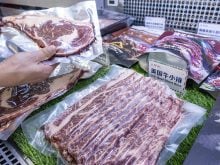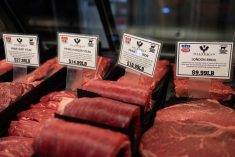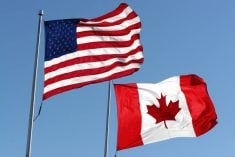While the main agricultural products exported from Canada to the United States are free from tariffs, U.S. trade policy as dictated by president Donald Trump is hurting Canadian farmers in a multitude of ways.
Tariffs on steel and aluminum are driving up costs for farm equipment. Most food and beverage products are tariff free but face increased documentation complexities. Other impacts are indirect, but substantial.
Trump’s trade war with China has meant no Chinese purchases of American soybeans for months. China is buying from Brazil instead.
Read Also

Lab-made food unlikely to win over shoppers
The future of food will not be defined by lab breakthroughs alone. Success will hinge on taste, transparency, affordability and respect for tradition.
Reports of a meeting between Trump and Chinese president Xi Jinping and a possible resolution to the impasse has recently had a positive impact on the markets, but soybean prices and by extension Canadian canola prices have been impaired.
A large, new U.S. farm aid package has been talked about but may be dropped or limited in scope if China and the U.S. can reach some common ground.
The Chinese tariffs on Canadian canola, peas and pork also have an American connection.
China says it would drop its tariffs if Canada drops the 100 per cent tariffs on Chinese electric vehicles. Unfortunately, that would likely sour Canadian relations with the U.S. and could lead to further trade retributions.
The unpredictable and thin-skinned U.S. president has cut off trade negotiations with Canada over Ontario’s television ads featuring former president Ronald Reagan explaining nearly 40 years ago why tariffs are bad for everyone’s economy. Imagine what Trump might do if Canada backtracked on Chinese EV tariffs.
Recent trade talks between Canada and the U.S. have concentrated on the imposition of American tariffs on the auto industry, steel and aluminum as well as softwood lumber. Yet to come is the renegotiation of the Canada-U.S.-Mexico Agreement.
Based on Trump’s love of tariffs and the apparent burr under his saddle regarding Canada’s supply management system for dairy, any new trade agreement is likely to inflict more economic pain. It’s hard to imagine a deal as favourable as the current accord.
In an unexpected development, Trump has also created some uncertainty in the beef sector. In response to consumer concerns over beef prices, Trump promised action and beef futures immediately declined.
The plan, later revealed, is to allow beef imports from Argentina to increase from 20,000 tons a year to 80,000. This isn’t sitting well with American cattle producers, who say high prices are needed to spur herd expansion.
The American and Canadian beef industries are highly integrated, but it isn’t yet clear if Canadian cattle prices will see sustained price pressure from the action.
It’s interesting that Trump’s solution to high beef prices is to reduce tariffs while his solution for everything else is to increase tariffs.
Opinions are mixed on the Reagan television ads initiated by Ontario premier Doug Ford. Trump initially sounded ambivalent over the ads and then for some reason became annoyed. Whenever challenged, he has a history of doubling down.
Whether the ads were a tactical mistake or served a purpose is a matter of debate. While pushing back on Trump’s policies may feel good, it doesn’t seem to be a winning strategy.
Before the blowup, prime minister Mark Carney seemed to be making some progress with Trump by deploying an affable demeanor rife with compliments. Trump clearly loves to have his ego stroked.
Some Canadians, particularly rural Canadians, are big Trump supporters. For most of us, the first 10 months into Trump’s second term already feels like an eternity.
















